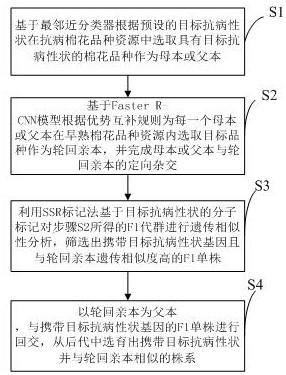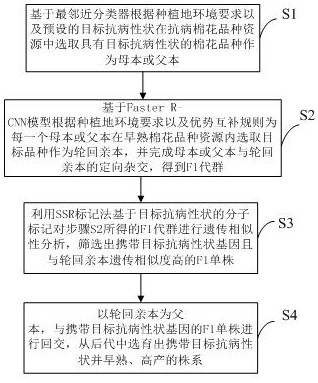Efficient breeding method for early-maturing disease-resistant cotton
A cotton variety and early-maturing technology, applied in the field of cotton breeding, can solve the problems of long breeding cycle, difficulty in screening new varieties, heavy workload, etc., and achieve the effects of improving the success rate, shortening the acquisition time, and speeding up the breeding speed.
- Summary
- Abstract
- Description
- Claims
- Application Information
AI Technical Summary
Problems solved by technology
Method used
Image
Examples
Embodiment 1
[0022] Such as figure 1 Shown, a kind of early-maturing disease-resistant cotton efficient breeding method comprises the steps:
[0023] S1. Based on the nearest neighbor classifier, select a cotton variety with the target disease-resistant trait as the female parent or the male parent in the disease-resistant cotton variety resource according to the preset target disease-resistant trait;
[0024] S2. Based on the Faster R-CNN model, select the target variety as the recurrent parent in the early-maturing cotton variety resources for each female parent or male parent according to the rules of complementary advantages, and complete the directional hybridization between the female parent or male parent and the recurrent parent;
[0025] S3. Using the SSR marker method to analyze the genetic similarity of the F1 generation population obtained in step S2 based on the molecular markers of the target disease resistance traits, and screen out F1 single plants that carry the target dis...
Embodiment 2
[0029] Such as figure 2 Shown, a kind of early-maturing disease-resistant cotton efficient breeding method comprises the steps:
[0030] S1. Based on the nearest neighbor classifier, according to the environmental requirements of the planting site and the preset target disease-resistant traits, select a cotton variety with target disease-resistant traits as the female parent or male parent from the disease-resistant cotton variety resources;
[0031] S2. Based on the Faster R-CNN model, according to the environmental requirements of the planting site and the rules of complementary advantages, select the target variety as the recurrent parent for each female parent or male parent in the early-maturing cotton variety resources, and complete the orientation of the female parent or male parent and the recurrent parent Hybridization to obtain the F1 generation group;
[0032] S3. Using the SSR marker method to analyze the genetic similarity of the F1 generation population obtaine...
PUM
 Login to View More
Login to View More Abstract
Description
Claims
Application Information
 Login to View More
Login to View More - R&D
- Intellectual Property
- Life Sciences
- Materials
- Tech Scout
- Unparalleled Data Quality
- Higher Quality Content
- 60% Fewer Hallucinations
Browse by: Latest US Patents, China's latest patents, Technical Efficacy Thesaurus, Application Domain, Technology Topic, Popular Technical Reports.
© 2025 PatSnap. All rights reserved.Legal|Privacy policy|Modern Slavery Act Transparency Statement|Sitemap|About US| Contact US: help@patsnap.com


